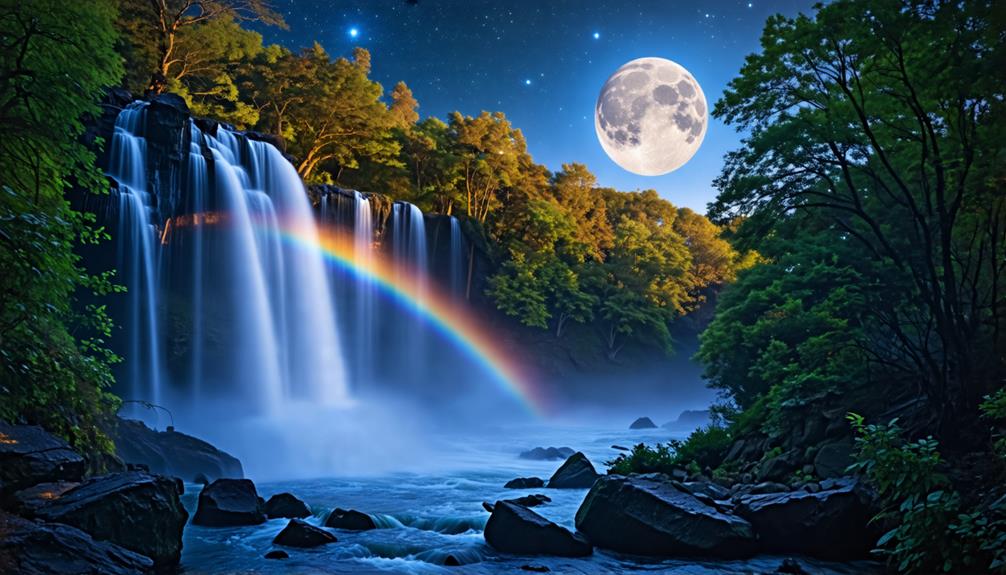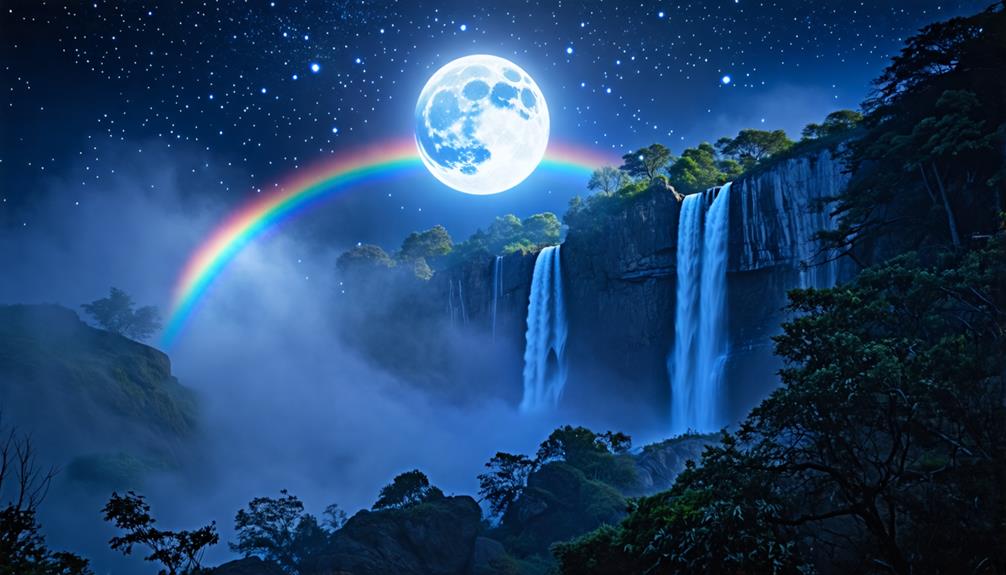You've likely heard of rainbows, but have you ever encountered their nocturnal cousin, the moonbow? These elusive lunar rainbows occur when moonlight refracts through water droplets, creating a mesmerizing spectacle in the night sky. While they're often colorless to the naked eye, moonbows hide a secret palette that can be revealed through long-exposure photography. To witness this rare phenomenon, you'll need specific conditions and perhaps a bit of luck. But what exactly makes moonbows so unique, and where can you find them? The answers might surprise you and inspire your next nighttime adventure.
Key Takeaways
- Moonbows form when moonlight refracts through water droplets in the atmosphere, similar to daytime rainbows.
- A nearly full moon positioned at least 42 degrees above the horizon is required for moonbow formation.
- Moonbows often appear white or colorless to the naked eye due to the dimmer light of the moon.
- Ideal viewing conditions include clear, dark skies and moisture in the air from sources like rain or waterfalls.
Moonbow Formation and Characteristics

Moonbows, nature's nocturnal cousins to rainbows, form when moonlight refracts through water droplets in the atmosphere, creating a mesmerizing yet elusive spectacle.
You'll need specific conditions to witness this rare phenomenon. A nearly full moon must be positioned at least 42 degrees above the horizon, with water droplets present opposite the moon in the night sky.
Unlike their vibrant daytime counterparts, moonbows often appear white or colorless to the naked eye due to the dimmer light from the moon. However, you can capture their hidden colors through long-exposure photography.
Moonbows are far rarer than solar rainbows, as they require precise atmospheric conditions, including low light pollution and high humidity.
Your best chances of spotting one are a few hours after sunset or before sunrise, especially in areas with frequent rainfall or mist.
Ideal Conditions for Viewing
To catch a glimpse of these ethereal night rainbows, you'll need a perfect alignment of celestial and terrestrial conditions.
For the best chance to see moonbows, aim for a night when the moon is nearly full, ideally within two days of its peak brightness. Position yourself opposite the moon, which should be low in the sky, no higher than 42 degrees above the horizon.
Clear, dark skies are essential, as light pollution can obscure these delicate phenomena. You'll also need moisture in the air, whether from rain, waterfalls, or ocean spray, to create the necessary water droplets.
Remember, timing is vital – the moon must be bright enough to illuminate these droplets, yet not so high that it interferes with the ideal viewing angle.
With patience and the right conditions, you might witness this rare nocturnal spectacle.
Notable Locations for Moonbows

While moonbows can theoretically appear anywhere with the right conditions, certain locations around the world have become famous for their frequent and spectacular displays.
You'll find some of the most reliable moonbow sightings at large waterfalls, where mist creates the necessary water droplets.
Victoria Falls, straddling Zambia and Zimbabwe, is renowned for its moonbows, especially with the moon behind the falls.
In the United States, Cumberland Falls in Kentucky offers consistent viewing opportunities during full moon phases. Yosemite National Park also provides chances to witness this phenomenon near its waterfalls.
Hawaii's diverse landscape makes it a prime spot for moonbow hunting.
For the best experience, seek out areas with minimal light pollution, such as remote national parks.
With patience and timing, you can capture stunning photos of these ethereal lunar rainbows.
Conclusion
You've learned about the enchanting moonbow phenomenon, a rare lunar rainbow created by moonlight.
Now you're equipped to seek out this ethereal spectacle. Remember, you'll need a nearly full moon, high in the sky, and water droplets in the air.
Don't be discouraged if it appears colorless at first; your camera might reveal hidden hues.
Keep an eye out for ideal conditions and notable viewing locations.
Happy moonbow hunting!

Leave a Reply